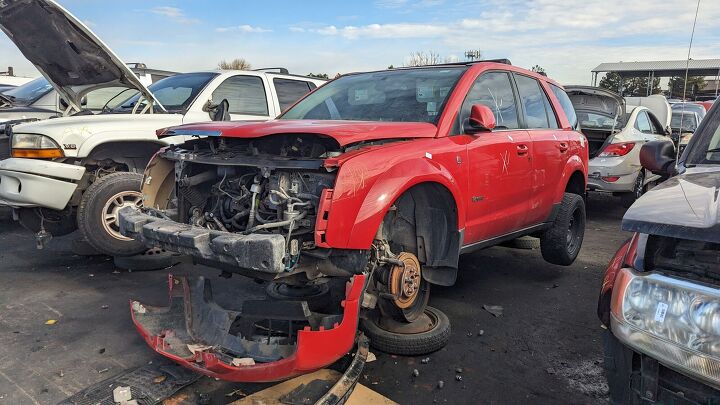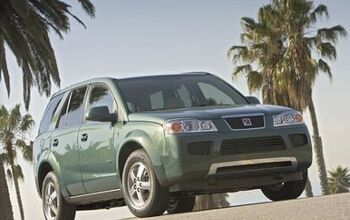Junkyard Find: 2007 Saturn Vue Green Line

Honda beat everybody to the production gasoline-electric hybrid game in the United States, putting the Insight in showrooms in 1999. Toyota followed with the Prius a year later, but it took GM until 2006 to introduce its first true gasoline-electric hybrid here. That car was the 2007 Saturn Vue Green Line, and I managed to find one in a Denver-area car graveyard recently.
Our nameless reviewer felt, back in 2006, that the Vue's panel gaps made it the "automotive equivalent of a shotgun shack" and calculated that the Green Line version would require 90,000 miles of driving with $2.15/gallon gas in order to recoup its cost over the pure-gazzoline version. In fact, fuel prices went insane right around the time that review was written.
If we look at the fine print, GM actually introduced a sort-of-a-hybrid vehicle as a 2004 model, though the 2004 Chevrolet Silverado Hybrid/GMC Sierra Hybrid didn't have regenerative braking.
Ford launched the Escape Hybrid as a 2005 model (its Mercury Mariner and Mazda Tribute siblings showed up a bit later), so The General had some catching up to do in the green-car department. Nissan introduced the Altima Hybrid as a 2007 model (and using licensed Toyota hardware), though it disappeared quickly and without leaving much trace.
Toyota and Honda didn't have much to fear from the Vue Green Line's hybrid technology, but it did benefit from regenerative braking and delivered a pretty good 23 city/29 highway miles per gallon (versus 19/25 mpg for the base Vue with 2.2-liter engine and automatic).
The system replaced the starter motor and alternator with a belt-driven motor/generator rig that generated five horsepower and 48 pound-feet. A 2.4-liter Ecotec gas-burner did most of the work with its 170 horsepower.
You could get a manual transmission in the regular Vue, but the Green Line was slushbox-only.
The green paint has faded from this Green Line badge, but it was supposed to be the Gaia-loving counterpart to the planet-ravaging Saturn Ion Red Line. I have mounted Red Line and Green Line badges side-by-side on my garage wall, in order to represent the duality of man.
The storm clouds over General Motors were getting darker by the minute when this car was built, and Saturn would soon have its head on the chopping block. Geo and Oldsmobile were already gone, with Pontiac and Saturn following in 2010.
The entry-level '07 Vue started at $17,995 (about $27,588 in 2024 dollars), while the Green Line version had an MSRP of $22,995 ($35,254 after inflation). Even with $4/gallon gas ($6.13 gallon in today's money), it would have taken quite a while to break even with the Green Line.
The Vue's platform outlived Saturn and still lives today, though. You'll find its derivatives underpinning everything from the Suzuki XL7 to the Wuling Almaz, and it all began with the 2002 Vue.
The interior isn't bad, but a 17-year-old non-AWD car made by a long-defunct brand doesn't command much resale value these days.
There is a way to recapture the world's imagination. To stay the same in one way, and evolve in another. Chapter 11 bankruptcy was approaching quickly, by the way.
A 2007 Saturn Vue Green Line hybrid in a Colorado wrecking yard.
A 2007 Saturn Vue Green Line hybrid in a Colorado wrecking yard.
A 2007 Saturn Vue Green Line hybrid in a Colorado wrecking yard.
A 2007 Saturn Vue Green Line hybrid in a Colorado wrecking yard.
A 2007 Saturn Vue Green Line hybrid in a Colorado wrecking yard.
A 2007 Saturn Vue Green Line hybrid in a Colorado wrecking yard.
A 2007 Saturn Vue Green Line hybrid in a Colorado wrecking yard.
A 2007 Saturn Vue Green Line hybrid in a Colorado wrecking yard.
A 2007 Saturn Vue Green Line hybrid in a Colorado wrecking yard.
[Images: The Author]
Become a TTAC insider. Get the latest news, features, TTAC takes, and everything else that gets to the truth about cars first by subscribing to our newsletter.

Murilee Martin is the pen name of Phil Greden, a writer who has lived in Minnesota, California, Georgia and (now) Colorado. He has toiled at copywriting, technical writing, junkmail writing, fiction writing and now automotive writing. He has owned many terrible vehicles and some good ones. He spends a great deal of time in self-service junkyards. These days, he writes for publications including Autoweek, Autoblog, Hagerty, The Truth About Cars and Capital One.
More by Murilee Martin
Latest Car Reviews
Read moreLatest Product Reviews
Read moreRecent Comments
- Proud2BUnion I've always been a fan of the Taurus/Sable, and Husker Du!
- Irvingklaws 2005 Honda Accord at about 125k miles - oil change, replace bad starter (also intake gasket), front and rear brakes, state inspection, about $1200 at a local garage. Front brakes were replaced free under warrantee because they were done last year. 2015 Mazda CX-5 with 102k - Took to dealer to diagnose "clunk" on takeoff and transmission slow to engage. After pointing out an apparent transmission leak and that nearly every bushing/boot under the car is cracked and/or failing in their inspection video, service techs said everything "looked safe". They tightened the cowl bolts in an (unsuccessful) attempt to address the clunk, completely side-stepped the transmission leak ("...it's a sealed unit, we can't touch it except to replace it entirely...") and charged me $450. About $33k to replace it with a new '24 Forester. Will be working on diagnosing and reconditioning the Mazda myself in the coming days...🙂
- Ezekiel sani
- GS340Pete All new cars, repairs only, in chronological order:1996 Eagle Vision Tsi: $400 in repairs in 90k miles, and an under warranty fuel rail replacement. Did I get lucky? 2001.5 VW 'New Jetta' 1.8T auto. Transmission self-destructed within six months. "You're lucky this was under warranty, this would have been like 11 grand." Traded it immediately. Electrical gremlins started showing up too. 2002 Nissan Pathfinder. One $400 repair out of warranty, 02 sensor, in 100k miles.2012 Nissan Maxima, $0 in 24k.2013 Nissan Altima, $0 in 50k.2014 Dodge Charger AWD. $400 sensor out of warranty in 130k. Again, did I get lucky?
- 1995 SC The Ridgeline is too new so nothing yet.The FIAT needed a tire (nail in the sidewall) and a lower steering column cover and a set of wipers. Around 200 bucksThe 30 year old Thunderbird has been needy this year. Just did fuel injectors to add to belts, hoses, motor mounts, exhaust manifold gasket, shocks and a bunch of caps replaced on various modules.Rear main has developed a small leak so I will probably have the transmission gone through when I drop it. I want to do a few things to it. I have some upgraded front calipers too but they are junk yard parts I rebuilt. Like I said, it has been needy this year but old cars do that sometimes





















































Comments
Join the conversation
I'll say one thing about those plastic bodies: they still look good after a decade and a half. Automakers should be sheathing their cars in petroleum-based plastic before they thin out the "sheet metal" to foil thickness.
There’s one of these around the corner from me. It still runs…driven daily, in fact. That fact always surprises me.